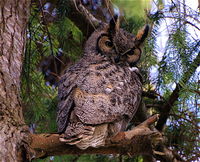Eagle owls
| Eagle owls | |
|---|---|

| |
| Great horned owl Bubo virginianus | |
| Scientific classification | |
| Kingdom Information | |
| Domain | Eukaryota |
| Kingdom | Animalia |
| Subkingdom | Bilateria |
| Branch | Deuterostomia |
| Phylum Information | |
| Phylum | Chordata |
| Sub-phylum | Vertebrata |
| Infraphylum | Gnathostomata |
| Class Information | |
| Superclass | Tetrapoda |
| Class | Aves |
| Sub-class | Neornithes |
| Infra-class | Neoaves |
| Order Information | |
| Order | Strigiformes |
| Family Information | |
| Family | Strigidae |
| Sub-family | Striginae |
| Genus Information | |
| Genus | Bubo |
| Population statistics | |
Bubo is a genus of owls of the family Strigidae, and commonly known as either eagle or horned owls, and includes 25 living species. Bubo includes some of the largest living owls.
Description
Eagle owls are large owls, with a subspecies of the Eurasian eagle owl (Bubo bubo sibiricus) reaching 31.4 inches in length and a wingspan of 5.9 feet. With the exception of the snowy owl (Bubo scandiacus) all species bear pronounced ear tufts, which give the group the alternate name of horned owls. The legs and toes are feathered in some species, others are bare.
Range and habitats
With the exception of the Antarctica, Australasia and some Pacific islands, eagle owls are widespread throughout the world, with most species found in Asia and Africa. In Europe only the Eurasian eagle owl (Bubo bubo) and the snowy owl occur; the snowy owl itself is also well established in North America, sharing it with the only other species found there, the great horned owl (Bubo virginianus).
The various species of eagle owl inhabit a variety of different habitats. These include equatorial rainforests, boreal forests, deserts, mountain regions, mangrove thickets, and Arctic tundra. The only prerequisite for a habitat settlement is a few trees or rock faces, in the protection of which they can breed and rest.
Species
Debate is still on-going as to the proper taxonomy of several species here referred to as fish or fishing owls; the genera in which they are also listed by many authorities is in parenthesis. According to molecular biology findings, the snowy owl, formerly in the genus Nyctea, must also be placed within this genus.
- Akun eagle-owl, Bubo leucostictus
- Barred eagle-owl, Bubo sumatranus
- Blakiston's fish-owl, (Ketupa) Bubo blakistoni
- Brown fish-owl, (Ketupa) Bubo zeylonensis
- Buffy fish-owl, (Ketupa) Bubo ketupu
- Cape eagle owl, Bubo capensis
- Dusky eagle-owl, Bubo coromandus
- Eurasian eagle owl, Bubo bubo
- Fraser's eagle owl, Bubo poensis
- Great horned owl, Bubo virginianus
- Greyish eagle owl, Bubo cinerascens
- Indian eagle owl, Bubo bengalensis
- Magellanic horned owl, Bubo magellanicus
- Pel's fishing-owl, (Scotopelia) Bubo peli
- Pharaoh eagle owl, Bubo ascalaphus
- Philippine eagle owl, Bubo philippensis
- Rufous fishing-owl, (Scotopelia) Bubo ussheri
- Shelley's eagle-owl, Bubo shelleyi
- Snowy owl, Bubo scandiacus
- Spot-bellied eagle owl, Bubo nipalensis
- Spotted eagle owl, Bubo africanus
- Tawny fish-owl, (Ketupa) Bubo flavipes
- Usumbara eagle owl, Bubo vosseleri
- Vermiculated fishing-owl, (Scotopelia) Bubo bouvieri
- Verreaux's eagle-owl, Bubo lacteus